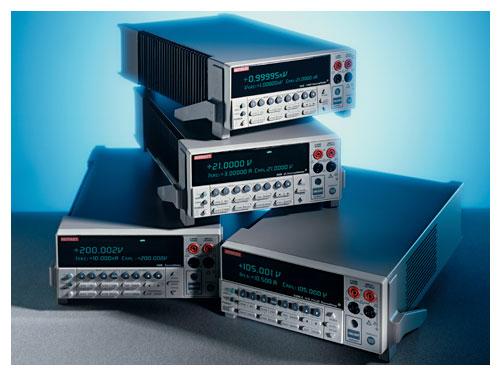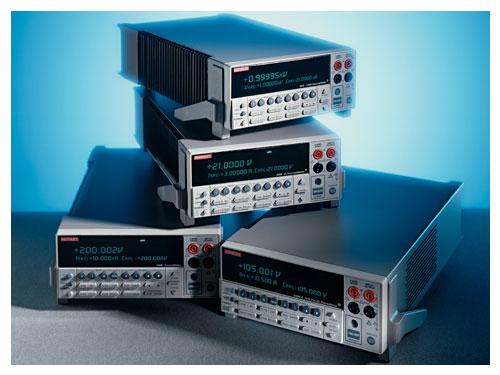December 20, 2015

As a test engineer, I appreciate versatile test equipment for several reasons. One, it can eliminate the many pieces of equipment usually needed for a test set. Fewer instruments usually equate to less money spent, less setup time, less maintenance, and faster development. Complex synchronization issues that can occur when multiple instruments are used may be minimized or eliminated. Two, versatile test equipment may be adaptable to future needs. And three, having one handy for engineering test setups such as characterization provides a way to get the job done quickly and accurately.
I started down the road of using source measurement units (SMUs) with the IEEE 488-compliant Keithley Instruments Model 2400 digital source meter back in the 1990s. I needed to select test instruments that met customer requirements for not only specific test parameters, but also for speed and accuracy. As an example, one test might have required the instrument to source 20 mA and read a voltage up to 2V. Another test might have required an instrument to source a negative voltage and read a current in the microamp range.

The Model 2400 is a 22W instrument with four-quadrant source or sink operation. It can source/sink plus or minus 21V at plus or minus 1.05 A and plus or minus 210V at plus or minus 105 mA. It has a 200-mV range with 1-mV resolution, as well as a 1-mA range with 10-pA resolution, meeting many basic test requirements and also being flexible enough to adapt to changes in test requirements. I do the majority of my testing via GPIB (IEEE 488) programming; the instrument is also SCPI compliant so you can talk to it either through a third-party test and measurement software package such as LabVIEW or you can input SCPI commands directly into it across the GPIB bus.
The SMU is also smart enough to operate outside of computer control with a built-in test sequencer, and that might be a good option if speed is essential. Safety is provided through programmable voltage and current compliance limits. High-speed triggering is available through the trigger link interface.
Since a SMU provides both a stable DC source (some SMUs can also provide pulse outputs) and a precision multi-meter, utilizing one in my test setups allows me a tremendous amount of flexibility with a variety of test situations. With one instrument type, there is no need to juggle separate meters and sources.
READ MORE ARTICLES BY NANCY GOLDEN ON DESIGN NEWS:
The versatility also allowed me to look like a hero; once I became familiar with its operation, I was able to use the SMU to set up test stations quite rapidly. I remember one incident when we had characterized a new product and, very unexpectedly, needed to get it tested that day, or we would have had some difficult consequences with the customer. Imagine being approached by the VP of engineering and asked if you could get an automated test set with data-logging capability running in just three or four hours. Using a couple of Keithley SMUs (a Model 2400 and a Model 2420 for a higher-current test), I was able to have a test system up and running for one of our production test operators in less than a day.
Because the Model 2400 can both source and measure in ranges that are typical for many semiconductor tests, I usually check it to see if it fits a customer's test requirements. But Keithley hasn't stopped with this workhorse; it now has an entire line of SMUs that can meet a variety of test requirements. SMUs with DC and pulsed output levels from 10W to 2,000W are part of the offerings. It has developed a graphical touchscreen interface on some models for test engineers who are inclined to use touch over knobs, buttons, and switches.

When selecting any test instrument, one should consider both current test scenarios and future needs. This can be accomplished by studying the product line that will be tested. Budget is always a factor, even though any test engineer would rather just focus on acquiring the best piece of test equipment for the job.
High-quality, versatile instruments will carry price tags that reflect their stability, precision, and worth. If you can afford them, they are well worth it. You can't get parts out the door without production test, and you can't have reliable test sets without precision test equipment.
Nancy Golden started her electronics career at Dallas Semiconductor and moved to Optek Technology where she was a test engineer for several years, eventually moving up to test engineering manager. Nancy became especially experienced in hall effect characterization and test and also gained experience with photologics, LEDs, VCSELs, and fiber optic transmission. She was also the first person to become a Certified TestPoint Application Specialist (CTAS) by Capital Equipment Corporation and has done contract work for Hitachi and Andrews Corporation and control room software for NBC in Testpoint. While employed at Optek Technology she also authored articles for Test and Measurement World on test system development. Nancy owns a small business called Golden Technical Creations, a service oriented company that provides consulting, teaching, PIC programming, course development and web design to its customers. She also has a M.A.R. with a focus on intercultural studies and is an adjunct faculty member at Dallas Christian College.
Like reading Design News? Then have our content delivered to your inbox every day by registering with DesignNews.com and signing up for Design News Daily plus our other e-newsletters. Register here!

Design engineers and professionals, the West Coast's most important design, innovation, and manufacturing event, Pacific Design & Manufacturing, is taking place in Anaheim, Feb. 9-11, 2016. A Design News event, Pacific Design & Manufacturing is your chance to meet qualified suppliers, get hands-on access to the latest technologies, be informed from a world-class conference program, and expand your network. (You might even meet a Design News editor.) Learn more about Pacific Design & Manufacturing here.
About the Author(s)
You May Also Like





